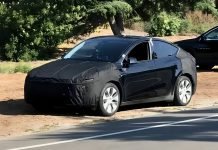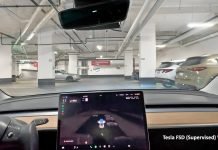While Tesla cars are not designed for cryptocurrency mining, there have been reports of many individuals attempting to utilize the onboard internal firmware of Tesla Model 3 vehicles to mine cryptocurrencies. Another news made rounds earlier when a Tesla owner used his Model S to make a rig and mine crypto.
Mining cryptocurrencies is a resource-intensive process that demands significant computational power. While Tesla vehicles are equipped with powerful onboard computers, they are primarily intended for running vehicle-related tasks and managing the car’s systems efficiently.
The computational capabilities of the onboard computer may not be on par with dedicated mining hardware, such as ASIC miners or powerful GPUs, which are commonly used for efficient mining operations.
In an exciting turn of events, a Model S owner made a crypto mining tig inside his EV using power from Tesla.
Sounds too good to be true? Or a bit cumbersome for all those innocent Tesla owners? Is it possible to mine crypto now in 2023? Let’s find out what we know so far in this post.

Table of Contents
Crypto Mining Using Tesla
In 2017, during the peak of Bitcoin’s popularity and its unprecedented price surge, the cryptocurrency gained significant attention and captured the interest of millions worldwide. With Bitcoin breaking the $10,000 barrier and reaching a market capitalization of $170 billion, the enthusiasm surrounding it continued to grow.
This craze motivated a Tesla owner to take an innovative step by constructing a functional cryptocurrency mining rig specifically designed to fit inside his Tesla Model S.
The purpose of this mining rig was to take advantage of the Supercharger network’s provision of free electricity. Tesla’s Supercharging program grants all Model S and Model X vehicles unlimited access to electricity, making it an attractive resource for the miner. The concept behind the mining rig was to use the power from this program, however, the specifics of his design are still unclear.
Utilizing Tesla’s computer system for cryptocurrency mining would necessitate granting users access to the system, which could potentially compromise the security and integrity of the vehicle’s operations. The computer system, particularly the Autopilot computer, plays a crucial role in implementing key safety features in Tesla models.
Given the critical nature of these features and the importance of maintaining a secure and reliable driving experience, most Tesla users have been dissuaded from venturing into cryptocurrency mining using the vehicle’s computer system. The potential risks associated with compromising the safety and performance of the vehicle outweigh the benefits of engaging in such activities.
But did that stop other users from using Tesla to mine crypto? No.
According to reports, a couple based in Wisconsin, who also happens to be electric car dealers, claimed to have successfully mined approximately $800 worth of cryptocurrency a month using their Tesla Model 3.
In another incident from Wisconsin, an EV dealer named Chris Allessi reportedly indulged in cryptocurrency mining using his Tesla Model 3. Chris utilized a power inverter and connected a Bitmain Antminer S9, a popular mining device, directly to the battery of his 2018 Model 3 to mine Monero and Bitcoin.
They both purportedly leveraged the vehicle’s onboard computer system and internal firmware to perform mining operations.
How Effective Is Crypto Mining Using Tesla?
The internal firmware of a Tesla car contains various systems and functionalities primarily related to driving, entertainment, and vehicle diagnostics. It is not explicitly designed or optimized for cryptocurrency mining, and utilizing it for such purposes can have several drawbacks.
One forum user with the name pseudopseudo aptly points out why it just doesn’t make sense to use Tesla vehicles to mine any kind of crypto:
“I don’t think that is an efficient way of mining bitcoins or any other cryptocurrency for that matter. I mean, you will want your Tesla computer to be managing your safety while you drive, and not mining some coins while you crash into a tree at 200 km/h.”
Crypto Mining Using Tesla In 2023
Tesla owners have found innovative and exciting ways to tap into the world of cryptocurrency mining using their vehicles. With advancements in technology and the growing popularity of cryptocurrencies, some Tesla owners have successfully explored the possibility of utilizing their vehicles for mining purposes.
Alejandro de la Torre, an experienced Bitcoin miner, has shared insights on the possibility of mining cryptocurrency using a Tesla vehicle. He highlights that, in some ways, mining from a Tesla is comparable to connecting to any other power source. However, the unique aspect lies in harnessing the vehicle itself as a power supply for mining operations.
According to de la Torre, the primary expense associated with mining is electricity, and if using an electric vehicle proves more cost-effective, it becomes an attractive option. One potential avenue for reducing costs is by leveraging solar power to charge the Tesla.
While the feasibility of solely relying on solar energy for intensive mining may be limited due to the substantial energy requirements, properties equipped with ample solar panels could theoretically utilize that energy for mining purposes. Although the specific rationale behind using a Tesla vehicle for mining remains somewhat unclear, it is conceivable to store solar energy in the car’s battery and employ it to power crypto mining, even during nighttime hours.
However, it is also true to note that such practices are not officially supported or endorsed by Tesla, and they may have potential drawbacks and limitations. And Tesla still has huge interest and holding in cryptocurrencies!
But is it possible or does it even make sense to mine crypto using Tesla EVs anymore? Let’s find out more.
Why Is It Not Possible Now?
Technically speaking, if someone manages to tap into their Tesla’s power to fuel mining systems, as claimed by this owner (although the method remains a mystery as to how they draw the required 2.8 kW from the battery), they could only truly benefit from free energy if their Tesla is part of the unlimited free Supercharging program, which applies to most Model S and Model X vehicles.
However, this approach comes with its own set of challenges. Ethically, it deviates from the intended purpose of the Supercharger network, which is primarily designed to facilitate long-distance travel rather than power mining rigs. Some might raise concerns about people using it for mining instead of enabling convenient, cross-country journeys.
Cryptocurrency mining is energy-intensive, and the process requires substantial electrical power to operate the mining equipment and maintain cooling systems. Tesla cars are designed to optimize energy efficiency for transportation purposes, and their battery capacity is primarily intended for driving the vehicle. Here’s why it does not make sense to use Tesla EVs for mining:
Battery Damage
Attempting to mine cryptocurrencies using the car’s electrical system can put a strain on the battery, potentially leading to a reduced driving range and increased wear on the battery cells.
Overheating
Mining generates heat, and maintaining appropriate cooling is crucial to prevent overheating of the mining equipment. Tesla cars are not designed with cooling systems suitable for mining operations, and prolonged mining activities could result in increased heat levels, potentially damaging the vehicle’s internal components.
Even for colder regions, apart from the potential benefit of preheating your car while simultaneously making some money, it remains uncertain what other practical applications someone would have for the generated heat.
Tesla Warranty
It’s worth mentioning that Tesla has implemented security measures and restrictions in their firmware to prevent unauthorized modifications and potentially unsafe operations. Engaging in activities like modifying the firmware for mining purposes may void the vehicle’s warranty and violate Tesla’s terms of service.
What To Expect In The Future?
“It’s a computer with wheels…It’s so simple to hack into this computer car,” said Siraj Raval sharing his YouTube video mining crypto with his Tesla EV.
Certain Tesla owners who bought their vehicles before 2017 were fortunate enough to be included in a special plan that grants them free and unlimited supercharging for the entire lifespan of their cars. However, despite having access to unlimited supercharging, some Tesla owners argue that utilizing their vehicles for cryptocurrency mining is not an efficient endeavor.
The process of mining cryptocurrencies requires substantial computational power, specialized hardware, and a considerable amount of energy. While unlimited supercharging provides an attractive prospect of free electricity, the computational capabilities of the Tesla vehicles may not be optimized for efficient mining operations.
The strain on the vehicle’s electrical system and potential battery degradation could outweigh the benefits of using free supercharging for mining purposes.
Bottomline
The scarcity of available bitcoins for mining poses a challenge, as the majority of the coins have already been mined. Additionally, the increasing number of individuals participating in mining activities intensifies competition and reduces the profitability for individual miners.
Elon Musk always favored Bitcoin but chose to no longer accept Bitcoin for Tesla EVs payments starting from 2021 pointing out climate impact.
While there have been reports of individuals attempting to mine cryptocurrencies using Tesla cars’ internal firmware, it is important to consider the limitations, potential risks, and the fact that Tesla does not officially support or endorse such activities.
Cryptocurrency mining is best suited for dedicated mining hardware optimized for computational power and energy efficiency, rather than repurposing a vehicle’s onboard computer system.
Considering the various limitations and potential drawbacks, aside from the allure of free power (which has its own downfalls), this setup fails to offer many significant advantages. Although, people do have some seriously innovative ideas to think out-of-the-box-solutions to things like crypto!



















Lol, no GPU’s are even connected in that pictures, all bunch of PCIE risers.
What a joke.